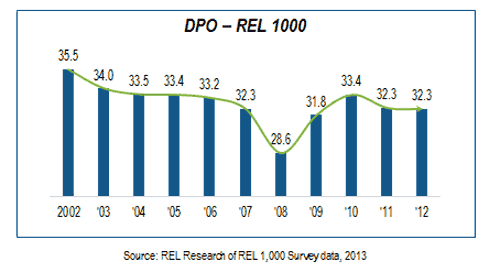|
|
 |
Focus: Sourcing/Procurement
Feature Article from Our Sourcing and Procurement Subject Area - See All |
|
From SCDigest's On-Target e-Magazine
- Aug. 7, 2013 -
Supply Chain News: Overall, Payment Terms to Suppliers Stayed Flat in 2012
Despite Some Signs Companies are Extending Payment Terms to Suppliers, No Rise in DPO in 2012, and Metric is Surprisingly Down over Last 10 Years
SDigest Editorial Staff
Of the three primary components of working capital performance, the payables area is perhaps the most problematic.
SCDigest Says: |
 |
Companies with higher gross or net profits margins should have a lower percentage of payables per dollar of sales than companies with lower margins. |
|
What Do You Say?
|
|
|
|
Precise definitions vary a bit, but in general the three areas that impact working capital changes are:
• How fast a company collects cash from its customers (accounts receivable)
• How much inventory a company holds
• How fast (or slow) a company pays its suppliers (accounts payable)
The reason why the latter element is somewhat controversial is that to make improvements to working capital (and therefore cash flow), a company has to stretch out payments to suppliers, which is great for a company's own metrics but comes at the expense of its suppliers' own cash flows and financial metrics.
For the past several years, SCDigest has performed analysis on the working capital data for the 1000 largest US companies compiled by REL, a Hackett Group company. We focus on the inventory component (see Which Companies have Seen String Inventory Performance Since 2006?), but this year will also look at the payables trends as well. The data for the 2013 report is for the 2012 financial year.
It is especially interesting to see the 2012 numbers in the context of several reports seen in 2013 saying that a number of companies, especially in the consumer products sector, were significantly extending payment terms for suppliers.
For example, we reported in May that Procter & Gamble was informing suppliers that it was extending payment terms from 45 days to 75 days, a move that would free up some $2 billion in cash flow annually for P&G. (See Procter & Gamble Late to the Game of Stretching Out Payments to Suppliers, but Ready to Join Party Now.)
Shortly thereafter, other CPG companies pushed the envelope even further. For example, Mondelez, the spinoff off out of Kraft Foods, sent a letter to suppliers in May that said it was extending payment terms to an amazing 120 days. (See Procter & Gamble Announcement on Longer Payment Terms Brings New Round of Extensions in Consumer Goods Industry.)
(Sourcing and Procurement Article Continues Below)
|
|
CATEGORY SPONSOR: SOFTEON |
| |
| |
|
|
|
REL Finds Days Payable Outstanding is Flat in 2012
Relative to payables, REL measures that metric in terms of Days Payables Outstanding (DPO), which measures how many day's worth of sales a company has in terms of payables. REL defines DPO as:
Year-End Accounts Payable /(Total Revenue/365)
That means an increase in DPO is an improvement, and a decrease a deterioration. For working capital and cash flow purposes, stretching out supplier payments is a good thing, regardless of the "business ethics" questions that could arise.
Despite the seeming trends in the consumer packaged goods sector discussed above, REL found that DPO was actually flat among across the 1000 public companies it follows, coming in at 32.3 days, the same as 2011.
In fact, somewhat surprising to SCDigest, average DPO was actually decreasing steadily from 2002 through 2008 and the start of the recession, falling over that time from 35.5 days to just 28.6. It then started to go the other direction after the great recession before flattening out the past two years, at levels still a couple of days shy of where this metric was in 2002.

REL believes companies in aggregate have substantial opportunity to improve working capital by increasing Days Payables Outstanding, finding for example that the top quintile (20%) had an average DPO level of 35.8 days, versus the median level of the entire company list of 24.7 days. It says the gap in DPO performance between leaders and average continues to widen each year.
While SCDigest loves the REL working capital data, we will note DPO is a unique and difficult metric, as suppliers facing extended payment terms are likely to raise prices to compensate for the late payments, mitigating the cash flow advantages from the longer terms.
Here are the average DPO metrics for a few select industry sectors:
• Consumer packaged goods: 32
• Pharmaceuticals: 28
• Mass Merchants, Dept. Stores, and Club Stores: 26
• Chemicals and Gases: 31
• Apparel and Shoe Manufacturers: 28
The range of DPO across sectors is not surprisingly much tighter than the extremely wide range of Days Inventory Outstanding. We will also note that differences across certain sectors or companies in overall business metrics could explain some difference in DPO rather than differences in payment practices.
For example, companies with higher gross or net profits margins should have a lower percentage of payables per dollar of sales than companies with lower margins.
Any reaction to these DPO numbers? Let us know your thoughts at the Feedback button (email) or section (web form) below.

|
|
|
Recent Feedback |
|
No Feedback on this article yet
|
|
| |
| |